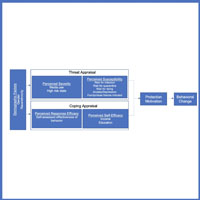Age differences in the relationship between threatening and coping mechanisms and preventive behaviors in the time of COVID-19 in the United States: Protection Motivation Theory

Submitted: August 8, 2020
Accepted: November 27, 2020
Published: January 14, 2021
Accepted: November 27, 2020
Abstract Views: 5662
PDF: 976
HTML: 29
HTML: 29
Publisher's note
All claims expressed in this article are solely those of the authors and do not necessarily represent those of their affiliated organizations, or those of the publisher, the editors and the reviewers. Any product that may be evaluated in this article or claim that may be made by its manufacturer is not guaranteed or endorsed by the publisher.
All claims expressed in this article are solely those of the authors and do not necessarily represent those of their affiliated organizations, or those of the publisher, the editors and the reviewers. Any product that may be evaluated in this article or claim that may be made by its manufacturer is not guaranteed or endorsed by the publisher.
Similar Articles
- Kim de Jong, Johanna Wilkens, Timothy Anderson, Kane Steggles, Facilitative interpersonal skills in benign versus challenging therapy situations in trainee therapists: a pilot study , Research in Psychotherapy: Psychopathology, Process and Outcome: Vol. 27 No. 2 (2024)
- Carla Alexandra Castro Cunha, Joana Spìnola, Miguel M. Goncalves, The Emergence of Innovative Moments in Narrative Therapy for Depression: Exploring Therapist and Client Contributions , Research in Psychotherapy: Psychopathology, Process and Outcome: Vol. 15 No. 2 (2012)
- Giorgia Margherita, Benedetta Muzii, Alessia Caffieri, Adriana Di Francia, Brenda Somma, ‘Isolated together’: online group treatments during the COVID-19 pandemic. A systematic review , Research in Psychotherapy: Psychopathology, Process and Outcome: Vol. 25 No. 3 (2022): SPECIAL ISSUE: "Group psychotherapy: between settled benchmarks and new horizons"
- Gonca Soygüt, İsmail Volkan Gülüm, A thematic analysis of therapists' perspectives on therapeutic alliance rupture moments , Research in Psychotherapy: Psychopathology, Process and Outcome: Vol. 19 No. 2 (2016)
- Alexandro Fortunato, Annalisa Tanzilli, Vittorio Lingiardi, Anna Maria Speranza, Psychodiagnostic Chart-Child (PDC-C): a valid and clinically sensitive diagnostic tool for patient-tailored intervention planning , Research in Psychotherapy: Psychopathology, Process and Outcome: Vol. 25 No. 1 (2022)
- Saryn R. Levy, Mark J. Hilsenroth, Francine Conway, Jesse Owen, Patient personality characteristics and therapeutic integration: treating borderline personality and emotionally dysregulated-dysphoric personality features , Research in Psychotherapy: Psychopathology, Process and Outcome: Vol. 25 No. 2 (2022)
- Irene Messina, Vincenzo Calvo, Alessandro Grecucci, Attachment orientations and emotion regulation: new insights from the study of interpersonal emotion regulation strategies , Research in Psychotherapy: Psychopathology, Process and Outcome: Vol. 26 No. 3 (2023)
- John E. Lothes II, Kirk D. Mochrie, Emalee J.W. Quickel, Jane St. John, Evaluation of a dialectical behavior therapy-informed partial hospital program: outcome data and exploratory analyses , Research in Psychotherapy: Psychopathology, Process and Outcome: Vol. 19 No. 2 (2016)
- Fabiola Bizzi, Francesca Locati, Laura Parolin, Shmueli Goetz Yael, Emanuela Brusadelli, Advancement in the child attachment interview and the child and adolescent reflective functioning scale using a PDM-2 framework: case reports , Research in Psychotherapy: Psychopathology, Process and Outcome: Vol. 25 No. 1 (2022)
- Francesca Locati, Pietro De Carli, Emanuele Tarasconi, Margherita Lang, Laura Parolin, Beyond the mask of deference: exploring the relationship between ruptures and transference in a single-case study , Research in Psychotherapy: Psychopathology, Process and Outcome: Vol. 19 No. 2 (2016)
<< < 4 5 6 7 8 9 10 11 12 13 > >>
You may also start an advanced similarity search for this article.

 https://doi.org/10.4081/ripppo.2020.485
https://doi.org/10.4081/ripppo.2020.485





